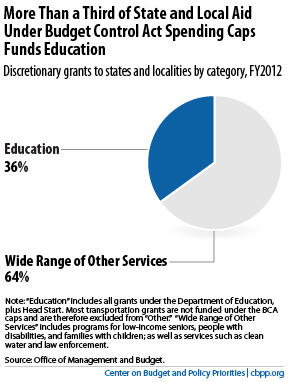BEYOND THE NUMBERS
What Deeper Cuts in “Non-Defense Discretionary Funding” Would Mean for States and Localities
If budget negotiators agree on a deficit-reduction deal, it could well include more cuts to the federal budget category that includes most grants to states and localities outside of Medicaid, on top of nearly $900 billion in cuts already enacted. But, there’s been little public discussion about how exactly further cuts would hurt states and localities.
Last year’s Budget Control Act (BCA) imposed severe caps over the next ten years on non-defense discretionary funding. As my colleague Nick Johnson has pointed out, the caps almost certainly will drive discretionary grants to states and localities far below historical levels. Lowering the BCA caps further as part of a deficit deal could prove very damaging in areas such as:

- Education. More than a third (36 percent) of the discretionary state and local aid that the caps cover goes to education, including funding for elementary and high schools to educate poor children and children with disabilities, Head Start, and certain higher education programs (see chart). School budgets, having absorbed years of state funding cuts, are in a poor position to face deep cuts in federal funding.
- Low-income programs. Some 35 percent of the discretionary state and local aid that the caps cover helps low-income people stabilize their lives and make it into the middle class. These programs include WIC (which provides nutritious food to new mothers and their babies), child care subsidies to enable low-income parents to take and keep jobs, and housing assistance for seniors, people with disabilities, and low-income families.
If states and localities have to scale back these programs because of insufficient federal funding, they may end up spending more down the road. Future health care costs may rise if more babies don’t get enough nutritious food, for example, and shelter costs may rise if more homeless people are on the street.
- Cuts to clean water projects, law enforcement, and other services. The rest of the discretionary state and local aid under the caps goes to a variety of other services that states and localities provide, including clean water projects, police departments, and job training. Shifting more of the costs of these services to states and localities would come at a particularly bad time, given states’ severe budget problems of recent years.
